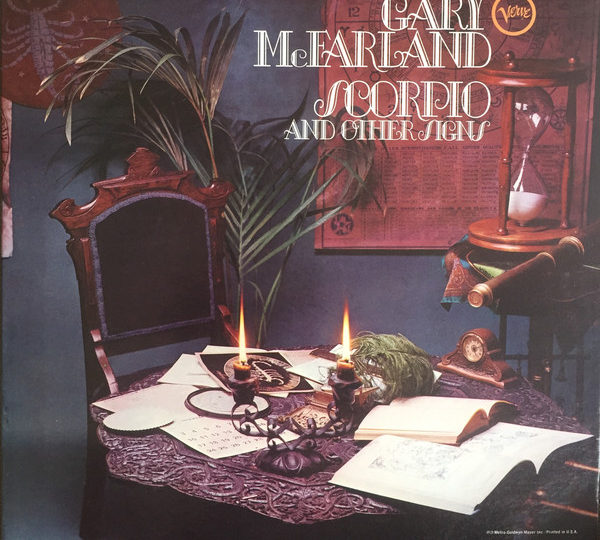
Gary McFarland’s Cinematic Forgotten Genius
Gary McFarland is a forgotten name by most music listeners. This is a tragedy since he was a bit of a genius- an arranger/conductor for jazz musicians, a cinematic composer of his own recordings, and a producer of a psychedelic hidden gem. Gary McFarland (born October 23, 1933) began his career arranging and conducting jazz musicians and singers, such as Anita O’Day, Bob Brookmeyer, John Lewis, Stan Getz, Gerry Mulligan, Gary Burton, Shirley Scott, and Zoot Sims. He also collaborated with pianist Bill Evans in 1963 (only four years after Bill Evans had performed on Miles Davis’ famous and influential Kind of Blue).
1966 was an innovative year for Gary McFarland. He composed his own autumnal, filmic cycle October Suite and he was commissioned to score a soundtrack for the British witchcraft horror movie Eye of the Devil. October Suite is contemplative, orchestral, and reflective jazz with experimental textures that must have had an influence upon David Axelrod (when he created the genre-defying Song of Innocence and Songs of Experience in 1968/1969) and on Eric Demarsan (when he composed the score for Jean-Pierre Melville’s Le Cercle Rouge in 1970). “Remember When”, the opening track, starts with avant-garde, minimalist piano from Steve Kuhn and a gloomy string quartet (Al Brown on viola, Charles McCracken on cello, and Isadore Cohen and Matthew Raimondi on violins). The piano switches to a more standard jazz accompaniment by bassist Ron Carter and drummer Marty Morell. “One I Could Have Loved” is plaintive and plangent, the strings are somber and sorrowful. “Traffic Patterns” on side two is, as the title suggests, less lugubrious and more dynamic and urbane. “Childhood Dreams” is the center and core of October Suite, melancholic and nostalgic, the listener can hear the wind scattering fallen leaves down empty streets. Gary McFarland weaves this mood through the woodwinds of Don Ashworth, Gerald Sanfino, Irving Horowitz, and Joe Firrantello. “Open Highway”, the closing track, is structured into three sections- the first is a downbeat feeling (like “Childhood Dreams””), the middle is more sprightly and vibrant (a car moving through autumnal landscapes in sparkling sunshine), and the final section returns to the wistful vibes that have dominated the record.
Eye of the Devil is an example of a soundtrack which is superior to the movie. Eye of the Devil was the acting debut of doomed Sharon Tate (who would be murdered only a few years later by the Manson family) and also features Deborah Kerr (who had appeared in another horror movie, The Innocents, only a few years before). Erwin Hillier’s black-and-white cinematography of the Chateau de Hautefort in Dordogne, France is more intriguing than the movie itself and Gary McFarland’s soundtrack is so strong that it stands on its own as a gothic gem. The “Main Theme” is a baroque, delicate harp melody. “Int. Chateau Night” features ghostly, haunting choral vocals that sound like they are wafting through the corridors of crumbling castle ruins. “Grave in the Forest” and “Nightmare” are more insistent and intense songs heavy on the horns and strings that, like many of the other tracks, are more typical of a 1960s horror movie score. Where Gary McFarland distinguishes himself the most is in “Procession” and “Catherine to Tower”. “Catherine to Tower” features the same ghostly, haunting chorals vocals as “Int. Chateau Night”, while “Procession” is the most memorable music on the soundtrack. Bells, chiming and crystalline, sound like December snowflakes falling upon a courtyard, while the ghostly, haunting choral vocals fade in yet again, their sounds more bleak, dismal, and dolorous, like a dark November twilight.
Gary McFarland attained his creative peak in 1968 with three records. The first album was his own Scorpio and Other Signs, a combination of funk, jazz, and lounge music for each of the twelve zodiac signs. Scorpio and Other Signs is structured around the seasons. The winter signs contain a cinematic, earthy rhythm section (“Take Care … Beware – Capricorn”), wistful whistling (“Whatever Whenever – Aquarius”), and mellow vibraphone (“Days Dipped in Dreams – Pisces”). The spring signs feature fiery funk and soulful female background vocalists (“Trying to Find a Way – Aries”) and breezy bossa nova/samba with an emphasis on flutes and soft wordless vocals (“No Other Way – Taurus” and “Thanks, But No Thanks – Gemini”). The summer signs start with the sensual (“Sad Eyes – Cancer”) and move on to a brassy, horns-laden organ vamp (“Long Live the King – Leo”) and another relaxing, soothing tune (“Close Your Eyes and Follow Me – Virgo”). The autumn signs range from the energetic, hand clapping, upbeat (“Can’t Help Dancing – Libra”) to an atmospheric groove with prominent bass and organ (“Runaway Heart – Scorpio”) to a serene, soporific closer (“I Don’t Need the Rain to See the Rainbows – Sagittarius”).
The second record was Dreams. In 1968, Gary McFarland formed his own label, Skye Records, with Hungarian guitarist Gabor Szabo and Latin percussionist Cal Tjader. Gabor Szabo’s Dreams featured eye-catching artwork from the book illustrator John Austen and Jim Stewart on guitar, Louis Kabok on bass, Jim Keltner on drums, Hal Gordon on percussion, Tony Miranda/Ray Alonge/Brooks Tillitson on horns, Julius Schacter on violin, George Ricci on cello, and Gary McFarland on piano and production. “Galatea’s Guitar” is a funky, rhythmic opening track by Szabo. Gary McFarland’s “Half the Day is the Night” contains nocturnal vibes. “Song of Injured Love” is Szabo’s adaptation of a piece by the Spanish composer Manuel de Falla. “The Fortune Teller” is led by Julius Schacter’s violin playing a gypsy melody, followed with dueling guitars by Szabo and Stewart, a deep bass groove by Louis Kabok, and Hal Gordon’s percussion and tambourine. “Fire Dance” is another adaptation of Manuel de Falla, this time from his ballet El Amor Brujo. “The Lady in the Moon” is a mellifluous jam.
The third record was Genesis, Gary McFarland’s crowning achievement as a producer. Cal Tjader, with whom he had co-founded Skye Records, was the godfather of teenage sisters Wendy and Bonnie Flower. Recorded during the autumn of 1968 and released during 1969, Wendy’s lyrics/singing and her sister Bonnie’s harmonies breathe beaded curtains and incense smoke (“Paisley Window Pane”). “I Realize You” benefits from the rhythm section of Randy Sterling on bass and Jim Keltner on drums. Gary McFarland’s chiming celeste adds to the atmosphere on the hypnotic, intoxicating, sensual “By the Sea”. Mike Melvoin’s keyboard leads “You Keep Hanging Up On My Mind”. “It’s What’s Really Happening” was a poem written by Wendy that was inspired by Robert Kennedy’s murder. The dark lyrics are hidden by the upbeat 60s instrumentation. “Five O’Clock in the Morning” is a misty and mysterious mood piece courtesy of Gary McFarland’s distant reverb on Wendy’s and Bonnie’s vocals. “Endless Pathway” features a deep bass groove by Randy Sterling and subtle wah-wah guitar by Larry Carlton. “Children Laughing” opens with Mike Melvoin’s carnivalesque organ as Wendy’s and Bonnie’s beautiful vocals intone the song’s title. “The Winter is Cold”, the closing track, features fantastic vocal harmonies from Wendy and Bonnie, psychedelic guitar from Larry Carlton, and another rock solid rhythm from bassist Randy Sterling and drummer Jim Keltner.
Gary McFarland planned to record a second album with Wendy and Bonnie, however, Skye Records went bankrupt in 1970 and on November 2, 1971, at the young age of only 38 years old, Gary McFarland died of a methadone overdose in a Greenwich Village bar. Gary’s son, Milo, died of a heroin overdose thirty years later the same age as his father. Gary McFarland’s story ends in sadness. Yet his cinematic genius remains in the music he recorded during the 1960s.
by Mark Lager

Hey Mark,
Your “forgotten name” description is actually on point. I’ve also never heard of him…
Just listened to “Eye of The Devil” and to some tracks of the Zodiac album, I was intrigued by the last track of that one (I’m a Sagittarius).
Very pleasant for the ears!
Hi Octavio,
Eye of the Devil is an example of a soundtrack superior to the film itself. I dig his Scorpio and Other Signs album, agreed that those are harmonious instrumentals.
(Recommend his October Suite, Gabor Szabo’s Dreams, and, most of all, Wendy and Bonnie – Genesis.)
I’m on a trip tube station this is beautiful
Recommend October Suite, Eye of the Devil soundtrack, Scorpio and Other Signs, Gabor Szabo’s Dreams, and, most of all, Wendy and Bonnie – Dreams.
*Wendy and Bonnie – Genesis
Drunk and fascinating.
Chris,
Recommend October Suite, Eye of the Devil soundtrack, Scorpio and Other Signs, Gabor Szabo’s Dreams, and, most of all, Wendy and Bonnie – Genesis.
Sounds awesome, thank you for the heads up!
Martin,
I recommend October Suite, Eye of the Devil soundtrack, Scorpio and Other Signs, Gabor Szabo’s Dreams, and, most of all, Wendy and Bonnie – Genesis.
I’ve never heard of him, but I’m also not very educated on jazz. Procession is awesome and beautifully described by you – it should be on your Halloween playlist!
Hi Saliha,
“Procession” is the most memorable on the Eye of the Devil soundtrack. (Recommend October Suite, Scorpio and Other Signs, Gabor Szabo’s Dreams, and, most of all, Wendy and Bonnie – Genesis).